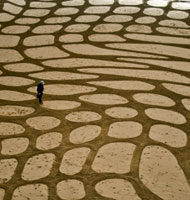
“Surf ‘n Turf”
By Benjamin Ortiz, for Café Latino Lifestyle Magazine
April/May 2010
Chaos fractals, moiré patterns, Islamic arabesques, crop circles, mathematical iterations and the divine geometry of sacred spaces: When San Francisco artist Andrés Amador started doodling with a stick in wet Hawaiian sand seven years ago, these ideas took hold and led him to stake out the tides and diurnal cycles, so he could transfer the intricate configurations in his head onto grainy canvasses stretching across 500 by 300 feet of Ocean Beach.
Like the Nazca Lines of Peru – expansive landscape glyphs with enigmatic etchings – Amador’s works suggest grand designs that are at once unearthly yet rooted in the natural movements of terra, sun and moon. That is, of course, until the tide rolls in to wash all of his work away forever. In the tradition of sandpainters from across indigenous cultures, Amador sketches ephemeral art onto beach topography as a lesson on life’s natural impermanence.
“Allowing the process to unfold as it will is a huge lesson,” he says in a phone conversation. “Everything that I do on the beach, all the art works that I do, all the art forms that I engage in are features of my own life.”
At 38 years old, Amador is a third-generation San Francisco native of Ecuadorian descent who grew up in the Mission District. But he didn’t go to the beach and had no artistic influences as a kid. “We were definitely below middle class,” he says of his upbringing, which made him very goal-oriented and focused on a practical career.
He imagined working as a park ranger and earned a degree in environmental sciences from University of California, Davis, but travels to Alaska and then Ecuador (on a Peace Corps assignment) helped him open up to chance digressions. In 1999, he started doing art, inspired by NevadaÂ’s Burning Man festival. The big, alternative desert party features art installations and on-the-spot collaborative creativity. Also, participants strike the location completely when the partyÂ’s over.
He later got involved with the Bay AreaÂ’s underground music and DJ scene, leading to experiments with psychedelic party design and light sculptures as elaborate decorations. He still makes such pieces, using string, light, sticks and principles of mathematical graphing. The sculptures got him thinking about cultural designs, harmonic patterns and geometry.
It was a short leap from that to the sand doodling experiences, and heÂ’s now done more than 100 beach pieces. When the lunar phase allows for time between high and low tides, so the sand can absorb water for optimal contrast, he uses various kinds of rakes with adjustable tines, plus ropes, stakes and other implements, to bring the plans and sketches from his notebooks to life.
Crowds sometimes show up to observe and even cheer him on, and he began to invite collaborators. Working with teams, he realized that his art would end up completely different than what he planned. “When I try to impose too much control, I might get what I’m looking for,” he mentions, “but I won’t be open to surprising myself with something entirely new, and by adding people to the mix who were essentially unpredictable, that was the element of chaos that I was needing.”
Even though the works disappear back into chaos, Amador shoots photos to transfer the art onto postcards and prints for sale. Like a meditative mandala architect, he has learned through the artistic process to let go of obsessive need for control. “I’ve grown more into the awareness that you can’t know where something is going to end up, because if you do, then it takes the heart out of it on some level, and not knowing is more interesting, has more potential,” he says.
« “The Elaborate Vision of Kristoffer Diaz” (Café Magazine) Ortiz selected for Dart Academic Fellowship »


